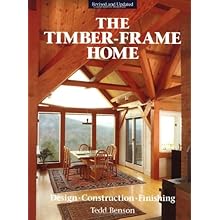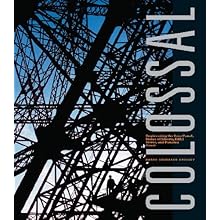The Timber-Frame Home: Design, Construction, Finishing - Tedd Benson
>> Friday, January 31, 2014


About the Author
Learning is acquired by reading books, acquire new knowledge whilst thinking over the old, and you may become a teacher of others.












Forty examples of advanced, ingenious, and responsible homes—each with fewer than 650 square feet of living space.


Passive solar heating and passive cooling—approaches known as natural conditioning—provide comfort throughout the year by reducing, or eliminating, the need for fossil fuel. Yet while heat from sunlight and ventilation from breezes is free for the taking, few modern architects or builders really understand the principles involved.
Now Dan Chiras, author of the popular book The Natural House, brings those principles up to date for a new generation of solar enthusiasts.
The techniques required to heat and cool a building passively have been used for thousands of years. Early societies such as the Native American Anasazis and the ancient Greeks perfected designs that effectively exploited these natural processes. The Greeks considered anyone who didn't use passive solar to heat a home to be a barbarian!
In the United States, passive solar architecture experienced a major resurgence of interest in the 1970s in response to crippling oil embargoes. With grand enthusiasm but with scant knowledge (and sometimes little common sense), architects and builders created a wide variety of solar homes. Some worked pretty well, but looked more like laboratories than houses. Others performed poorly, overheating in the summer because of excessive or misplaced windows and skylights, and growing chilly in the colder months because of insufficient thermal mass and insulation and poor siting.
In The Solar House, Dan Chiras sets the record straight on the vast potential for passive heating and cooling. Acknowledging the good intentions of misguided solar designers in the past, he highlights certain egregious—and entirely avoidable—errors. More importantly, Chiras explains in methodical detail how today's home builders can succeed with solar designs.
Now that energy efficiency measures including higher levels of insulation and multi-layered glazing have become standard, it is easier than ever before to create a comfortable and affordable passive solar house that will provide year-round comfort in any climate.
Moreover, since modern building materials and airtight construction methods sometimes result in air-quality and even toxicity problems, Chiras explains state-of-the-art ventilation and filtering techniques that complement the ancient solar strategies of thermal mass and daylighting. Chiras also explains the new diagnostic aids available in printed worksheet or software formats, allowing readers to generate their own design schemes.


"Clear, practical book ... full-color photos help do-it-yourselfers realize their dreams." -- Log Homes Illustrated
The best-selling Cabins is back in print, at the same great value of its original price. This authoritative how-to title gives readers all the information they need to build their own cabin, including:
Construction methods are clearly illustrated in meticulous line drawings and precise plans with measurements. Cut-away cross-sections and exploded diagrams give the builder the true perspective and detail needed to obtain the best result, allowing readers to get the most enjoyment out of their newly built wilderness retreat.







Over 70 percent of Americans cannot afford to own a code-enforced, contractor-built home. This has led to widespread interest in using natural materials—straw, cob, and earth—for building homes and other buildings that are inexpensive, and that rely largely on labor rather than expensive and often environmentally-damaging outsourced materials.
Earthbag Building is the first comprehensive guide to all the tools, tricks, and techniques for building with bags filled with earth—or earthbags. Having been introduced to sandbag construction by the renowned Nader Khalili in 1993, the authors developed this "Flexible Form Rammed Earth Technique" over the last decade. A reliable method for constructing homes, outbuildings, garden walls and much more, this enduring, tree-free architecture can also be used to create arched and domed structures of great beauty—in any region, and at home, in developing countries, or in emergency relief work.
This profusely illustrated guide first discusses the many merits of earthbag construction, and then leads the reader through the key elements of an earthbag building:
Special design considerations
Foundations, walls and floors
Electrical, plumbing and shelving
Lintels, windows and door installations
Roofs, arches and domes
Exterior and interior plasters.
With dedicated sections on costs, making your own specialized tools, and building code considerations, as well as a complete resources guide, Earthbag Building is the long-awaited, definitive guide to this uniquely pleasing construction style.
Kaki Hunter and Donald Kiffmeyer have been involved in the construction industry for the last 20 years, specializing in affordable, low-tech, low-impact building methods that are as natural as possible. They developed the "Flexible Form Rammed Earth Technique" of building affordably with earthbags and have taught the subject and contributed their expertise to several books and journals on natural building.



Created by an international team of architects and designers concerned about our failing education system, The Third Teacher explores the critical link between the school environment and how children learn, and offers 79 practical design ideas, both great and small, to guide reader’s efforts to improve our schools. Written for anyone who has school-age children in their life, from educators and education decision-makers to parents and community activists, this book is intended to ignite a blaze of discussion and initiative about environment as an essential element of learning. Including a wealth of interviews, facts, statistics, and stories from experts in a wide range of fields, this book is a how-to guide to be used to connect with the many organizations, individuals, and ideas dedicated to innovating and improving teaching and learning. Contributors include children’s singer and advocate Raffi, author and creativity consultant Sir Ken Robinson, scientist and environmentalist David Suzuki, inventor James Dyson, and other experts who are working to create fresh solutions to problems and create a new blueprint for the future of education.
